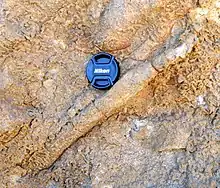Muensteria
Muensteria is the ichnogenus of a type of trace fossil that is found in sedimentary rocks, and is thought to represent the horizontal burrow of a marine invertebrate organism. It is a horizontal, non-branching, unlined, tube-like burrow characterized by menisci, which are concave to flat laminae within the burrow created as the organism packs sediment and fecal material behind it when moving forward in the burrow. Muensteria is one example of a meniscate burrow.[1][2]
| Muensteria | |
|---|---|
 | |
| Muensteria trace fossil from the Temblor Formation (Lower Miocene) of Kern County, California. Note the menisci (back-filling structures) in the burrow. | |
| Trace fossil classification | |
| Domain: | Eukaryota |
| Kingdom: | Animalia |
| Phylum: | Annelida |
| Clade: | Pleistoannelida |
| Subclass: | Sedentaria |
| Order: | Sabellida |
| Family: | Sabellidae |
| Ichnogenus: | †Muensteria Sternberg, 1833 |
See also
References
- Chamberlain, C. K. (1978). "Recognition of trace fossils in cores". In Basan, P.N. (ed.). Trace Fossil Concepts - SEPM Short Course No. 5. Oklahoma City: Society of Economic Paleontologists and Mineralogists. pp. 133–162.
- Howard. J. D. & Frey, R. W. (1984). "Characteristic trace fossils in nearshore to offshore sequences, Upper Cretaceous of east-central Utah". Canadian Journal of Earth Sciences. 21 (2): 200–219. Bibcode:1984CaJES..21..200H. doi:10.1139/e84-022.
Wikimedia Commons has media related to Muensteria.
This article is issued from Wikipedia. The text is licensed under Creative Commons - Attribution - Sharealike. Additional terms may apply for the media files.